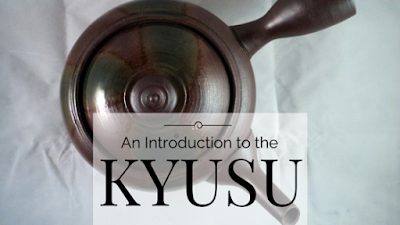It’s a little-known fact that kyusu is simply the Japanese word for teapot. We usually think of them as side-handled teapots but they can also have handles on the rear or even on the top. Porcelain and clay are the most common mediums but kyusu can be made from a number of materials. The
handles are usually hollow in order to prevent them from becoming too hot to hold. Kyusu have wider bodies that allow heat to dissipate, making them perfect for sensitive teas like sencha.
Kyusu are different from other teapots because they are designed specifically for making green tea and they usually feature some sort of built-in filter. Sasame filters feature a series of holes made directly in the ceramic. Wrap-around or belt filters are made out of very fine stainless steel mesh. Swing filters cover the bottom of the pot as well as the spout. This keeps the leaves from continuing to stew in residual water.
Side-handled kyusu are called kokode. This style evolved because the host sits directly across from the guest in a traditional tatami mat tea room. There are even special kyusu made just for left-handed tea drinkers for this reason. Kyusu without handles are called houhin, meaning treasure vessel. They are mostly used for making gyokuro as the lower water temperature makes it easier to pour without burning yourself.
It’s important to completely empty your kyusu once the tea is done brewing. Depending on the tea, this could be anywhere from 30 seconds to 5 minutes. Follow your tea vendor’s recommendations and then adjust to taste from there. Green teas can become very bitter if the leaves are allowed to say in the water. Many tea drinkers find that the beginning of the pour will taste very different from the end. An easy solution is to use multiple cups, pouring back and forth in order to evenly distribute the flavor between them all.
Proper care of your kyusu will ensure years of enjoyable drinking. Take care not to bump the spout or handle because they can easily break off if handled too roughly. Dried leaves are nearly impossible to remove from the fine mesh screens so it best to rinse them out as soon as possible. If your kyusu is unglazed, avoid washing it with dish soap as this will negatively affect the taste of the tea.




